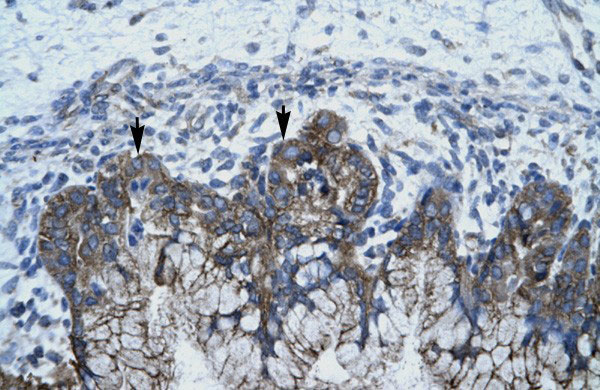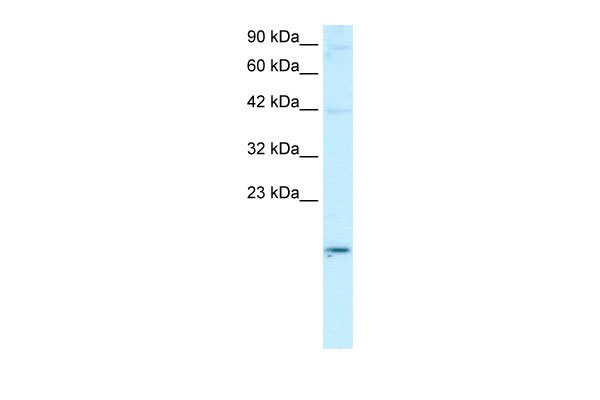APOBEC3G antibody - N-terminal region
Rabbit Polyclonal Antibody
- 产品详情
- 实验流程
- 背景知识
Application
| WB, IHC |
|---|---|
| Primary Accession | Q9HC16 |
| Other Accession | Q9HC16-2, NP_068594, NM_021822 |
| Reactivity | Human, Pig |
| Predicted | Human |
| Host | Rabbit |
| Clonality | Polyclonal |
| Calculated MW | 46408 Da |
| Gene ID | 60489 |
|---|---|
| Alias Symbol | HL-2, HBXBP, ASGPR2, ASGP-R2, CLEC4H2, APOBEC3G |
| Other Names | DNA dC->dU-editing enzyme APOBEC-3G, 354-, APOBEC-related cytidine deaminase, APOBEC-related protein, ARCD, APOBEC-related protein 9, ARP-9, CEM-15, CEM15, Deoxycytidine deaminase, A3G, APOBEC3G |
| Target/Specificity | APOBEC3G is a member of the cytidine deaminase gene family. It is one of seven related genes or pseudogenes found in a cluster, thought to result from gene duplication, on chromosome 22. Members of the cluster encode proteins that are structurally and functionally related to the C to U RNA-editing cytidine deaminase APOBEC1. It is thought that the proteins may be RNA editing enzymes and have roles in growth or cell cycle control. The protein encoded by this gene has been found to be a specific inhibitor of human immunodeficiency virus-1 (HIV-1) infectivity. |
| Format | Liquid. Purified antibody supplied in 1x PBS buffer with 0.09% (w/v) sodium azide and 2% sucrose. |
| Reconstitution & Storage | Add 50 ul of distilled water. Final anti-APOBEC3G antibody concentration is 1 mg/ml in PBS buffer with 2% sucrose. For longer periods of storage, store at -20°C. Avoid repeat freeze-thaw cycles. |
| Precautions | APOBEC3G antibody - N-terminal region is for research use only and not for use in diagnostic or therapeutic procedures. |
| Name | APOBEC3G {ECO:0000303|PubMed:14557625, ECO:0000312|HGNC:HGNC:17357} |
|---|---|
| Function | DNA deaminase (cytidine deaminase) which acts as an inhibitor of retrovirus replication and retrotransposon mobility via deaminase- dependent and -independent mechanisms (PubMed:12808465, PubMed:16527742, PubMed:17121840, PubMed:18288108, PubMed:18849968, PubMed:19153609, PubMed:21123384, PubMed:22791714, PubMed:25542899). Exhibits potent antiviral activity against Vif-deficient HIV-1 (PubMed:12167863, PubMed:12859895, PubMed:14557625, PubMed:20219927, PubMed:21835787, PubMed:22807680, PubMed:22915799, PubMed:23097438, PubMed:23152537, PubMed:31397674). After the penetration of retroviral nucleocapsids into target cells of infection and the initiation of reverse transcription, it can induce the conversion of cytosine to uracil in the minus-sense single-strand viral DNA, leading to G-to-A hypermutations in the subsequent plus-strand viral DNA (PubMed:12808465, PubMed:12808466, PubMed:12809610, PubMed:12970355, PubMed:14528300, PubMed:22807680). The resultant detrimental levels of mutations in the proviral genome, along with a deamination-independent mechanism that works prior to the proviral integration, together exert efficient antiretroviral effects in infected target cells (PubMed:12808465, PubMed:12808466, PubMed:12809610, PubMed:12970355, PubMed:14528300). Selectively targets single-stranded DNA and does not deaminate double-stranded DNA or single- or double-stranded RNA (PubMed:12808465, PubMed:12809610, PubMed:12970355, PubMed:14528300). Exhibits antiviral activity also against simian immunodeficiency viruses (SIVs), hepatitis B virus (HBV), equine infectious anemia virus (EIAV), xenotropic MuLV-related virus (XMRV) and simian foamy virus (SFV) (PubMed:15031497, PubMed:16378963, PubMed:18448976, PubMed:19458006, PubMed:20335265). May inhibit the mobility of LTR and non-LTR retrotransposons (PubMed:16527742). |
| Cellular Location | Cytoplasm. Nucleus Cytoplasm, P-body. Note=Mainly cytoplasmic (PubMed:16527742, PubMed:16699599, PubMed:21835787). Small amount are found in the nucleus (PubMed:18667511). During HIV-1 infection, virion-encapsidated in absence of HIV-1 Vif (PubMed:12859895) |
| Tissue Location | Expressed in spleen, testes, ovary and peripheral blood leukocytes and CD4+ lymphocytes. Also expressed in non-permissive peripheral blood mononuclear cells, and several tumor cell lines; no expression detected in permissive lymphoid and non-lymphoid cell lines Exists only in the LMM form in peripheral blood-derived resting CD4 T- cells and monocytes, both of which are refractory to HIV-1 infection LMM is converted to a HMM complex when resting CD4 T-cells are activated or when monocytes are induced to differentiate into macrophages. This change correlates with increased susceptibility of these cells to HIV-1 infection. |
For Research Use Only. Not For Use In Diagnostic Procedures.
Provided below are standard protocols that you may find useful for product applications.
BACKGROUND
This is a rabbit polyclonal antibody against APOBEC3G. It was validated on Western Blot and immunohistochemistry by Abgent. At Abgent we manufacture rabbit polyclonal antibodies on a large scale (200-1000 products/month) of high throughput manner. Our antibodies are peptide based and protein family oriented. We usually provide antibodies covering each member of a whole protein family of your interest. We also use our best efforts to provide you antibodies recognize various epitopes of a target protein. For availability of antibody needed for your experiment, please inquire (sales@abgent.com).
终于等到您。ABCEPTA(百远生物)抗体产品。
点击下方“我要评价 ”按钮提交您的反馈信息,您的反馈和评价是我们最宝贵的财富之一,
我们将在1-3个工作日内处理您的反馈信息。
如有疑问,联系:0512-88856768 tech-china@abcepta.com.























 癌症的基本特征包括细胞增殖、血管生成、迁移、凋亡逃避机制和细胞永生等。找到癌症发生过程中这些通路的关键标记物和对应的抗体用于检测至关重要。
癌症的基本特征包括细胞增殖、血管生成、迁移、凋亡逃避机制和细胞永生等。找到癌症发生过程中这些通路的关键标记物和对应的抗体用于检测至关重要。 为您推荐一个泛素化位点预测神器——泛素化分析工具,可以为您的蛋白的泛素化位点作出预测和评分。
为您推荐一个泛素化位点预测神器——泛素化分析工具,可以为您的蛋白的泛素化位点作出预测和评分。 细胞自噬受体图形绘图工具为你的蛋白的细胞受体结合位点作出预测和评分,识别结合到自噬通路中的蛋白是非常重要的,便于让我们理解自噬在正常生理、病理过程中的作用,如发育、细胞分化、神经退化性疾病、压力条件下、感染和癌症。
细胞自噬受体图形绘图工具为你的蛋白的细胞受体结合位点作出预测和评分,识别结合到自噬通路中的蛋白是非常重要的,便于让我们理解自噬在正常生理、病理过程中的作用,如发育、细胞分化、神经退化性疾病、压力条件下、感染和癌症。







